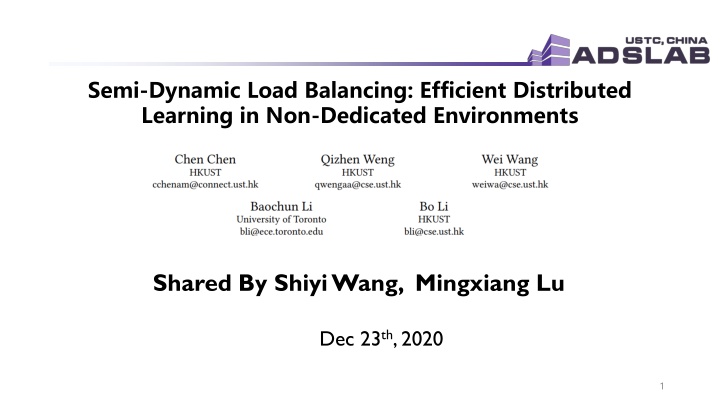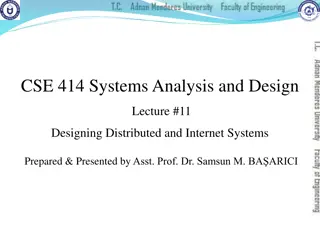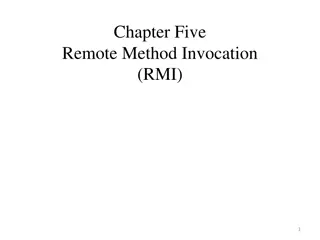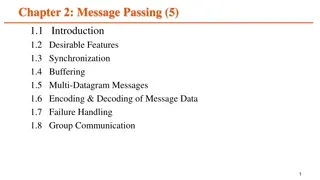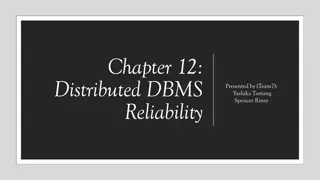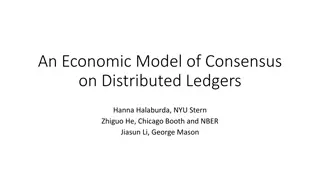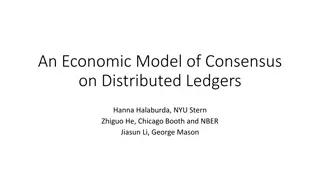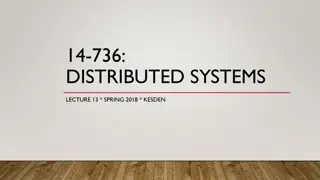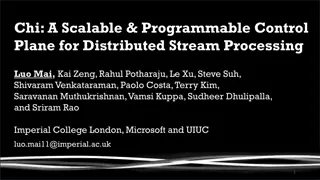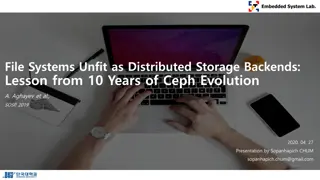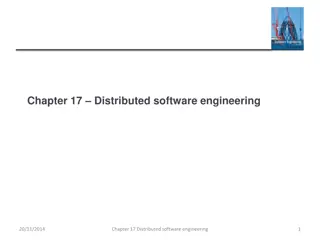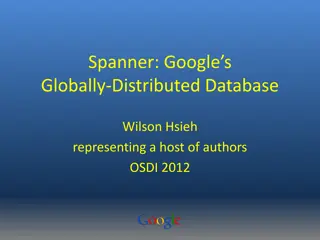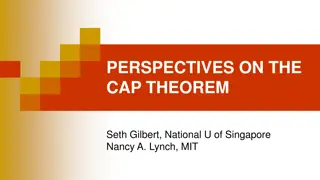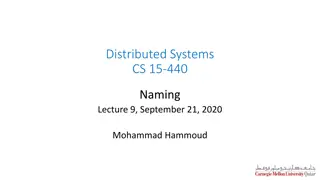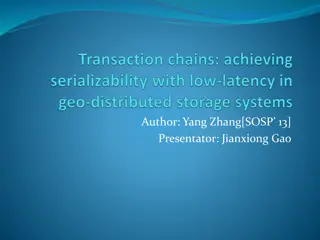Efficient Distributed Learning in Non-Dedicated Environments
This research discusses semi-dynamic load balancing methods for efficient distributed machine learning in non-dedicated cluster environments. It covers topics like stragglers in distributed model training, bypassing stragglers with relaxed synchronization, and mitigating stragglers through redundant execution. The study explores cluster environments, distributed learning, and strategies to enhance distributed model training processes.
Uploaded on Feb 22, 2025 | 2 Views
Download Presentation

Please find below an Image/Link to download the presentation.
The content on the website is provided AS IS for your information and personal use only. It may not be sold, licensed, or shared on other websites without obtaining consent from the author.If you encounter any issues during the download, it is possible that the publisher has removed the file from their server.
You are allowed to download the files provided on this website for personal or commercial use, subject to the condition that they are used lawfully. All files are the property of their respective owners.
The content on the website is provided AS IS for your information and personal use only. It may not be sold, licensed, or shared on other websites without obtaining consent from the author.
E N D
Presentation Transcript
Semi-Dynamic Load Balancing: Efficient Distributed Learning in Non-Dedicated Environments Shared By Shiyi Wang, Mingxiang Lu Dec 23th, 2020 1
Outline Background Related work Design Experiments and Evaluation Conclusion 2
Distributed Machine Learning Distribute the model training process to multiple workers: Bulk Synchronous Parallel(BSP): Barrier Parameter Server Worker1 gn g2 Worker2 g1 Worker1 Worker2 Workern Worker3 B1 B2 Bn Worker4 Sample Input Stream Iteration k+2 Iteration k Iteration k+1 3
Cluster Environments for Distributed Learning Dedicated Clusters Homogeneous Hardware No Sharing Expensive and Scarce Non-Dedicated Clusters Heterogeneous Hardware Dynamic Resource in Shared Cluster Cheap and Abundant 4
Stragglers in Distributed Model Training Deterministic Stragglers Non-deterministic Stragglers Worker1 Worker1 Worker2 Worker2 Worker3 Worker3 Worker4 Worker4 Iteration k Iteration k+1 Iteration k+2 Iteration k Iteration k+1 Iteration k+2 Non-deterministic Stragglers OS jitter, Garbage Collection Dedicated & Non-dedicated Clusters Transient & Slight Low Deterministic Stragglers Inconsistent Resource Quality/Quantity Only in Non-dedicated Clusters Causes Existence Characteristics Significance Long-lasting & Salient High 5
Outline Background Related work Design Experiments and Evaluation Conclusion 6
Bypassing Stragglers With Relaxed Synchronization Asynchronous Parallel (ASP) Stale Synchronous Parallel (SSP) Workers iterate independently Bound the max iteration gap among workers Iteration Gap quota easily used up More iterations required to converge Worker1 Worker1 Worker2 Worker2 Worker3 7
Mitigate Stragglers By Redundant Execution Training models with backup workers and synchronize a subset finishing the earliest Worker1 Worker2 Worker3 Worker4 Iteration k+2 Iteration k Iteration k+1 8
Eliminate Stragglers By Load Balancing Static Load Balancing Dynamic Load Balancing Work-stealing(e.g.FlexRR Responding to dynamic changes Given scheme(e.g. Round-Robin) Low overhead Cannot react to resource variations Much higher overhead All-or-nothing processing 9
Design Objectives Worker Coordination Schemes Practical (ML Framework Compatibility) Effective (Fast training Convergence) Efficient (Low Overhead) ASP SSP Redundant Execution(+BSP) Static Load Balancing(+BSP) Dynamic Load Balancing(+BSP) ? 10
Semi-dynamic Load Balancing Static Load within each iteration [Pros]Light-weight [Pros]Compatible with the tensor-based batch processing style Dynamic Load across different iteration Load balance at iteration boundaries of BSP [Pros]Effective for resource variations 11
Outline Background Related work Design Experiments and Evaluation Conclusion 12
Problem Formulation Worker1 Worker2 Worker3 Worker4 Iteration k+1 Iteration k+2 Iteration k ? = (?1, ?2, ...,?n) : worker batch size ??: Computation time ??: Communication time 13
LB-BSP in CPU Clusters Characteristics: Negligible Communication Time Linear Relationship 14
LB-BSP in CPU Clusters Other factors: RAM Usage CPU Usage 15
Predicting Sample Processing Speed Potential Approaches Memoryless Exponential Moving Average(EMA) Autoregressive Integrated Moving Average (ARIMA) Plain RNN & LSTM Nonlinear AutoRegressive eXogenous (NARX) -extended RNN 16
LB-BSP in GPU Clusters Characteristics: Non-negligible Communication Time Non-negligible GPU Launching Overhead GPU Saturation Effect: ? ? = ? ? < ?? GPU Memory Limitation: ? < ?? 18
Challenges & Opportunities Challenges: analytical method is in appropriate Opportunities: Batch processing time increases monotonically with batch size. Worker performance is stable in most consecutive iterations Numerical approximation method 19
Numeral Method Two roles: Leader Straggler Two phases: Fast-approach Fine-tune 20
Weighted Gradient Aggregation Na ve Aggregation: Weighted Gradient Aggregation: 21
Outline Background Related work Design Experiments and Evaluation Conclusion 22
LB-BSP implementation BatchSizeManager A Python module pluggable for modern ML frameworks 23
Experimental Setup Performance 16-node GPU cluster 140 32-node CPU cluster 120 Instance Type GPU Type Number Instance Type CPU (core) 8 RAM (GB) 32 Number 100 m4.2xlarge 17 p3.2xlarge Tesla V100 GPU 4 80 TFLOPS c5.2xlarge 8 16 10 g3.4xlarge Tesla M60 GPU 4 60 p2.xlarge Tesla K80 GPU 4 r4.2xlarge 8 61 2 40 g2.2xlarge GRID K520 GPU 4 m4.4xlarge 16 64 2 20 m4.xlarge 4 16 1 0 V100 M60 K80 K520 GPU Type 24
Experimental Setup Model && Datasets Model Dataset Size CifarNet CIFAR-10 dataset 60000 training images in 10 classes[1] ResNet-32 CIFAR-10 dataset Inecption-V3 ImageNet dataset 1.28 million training images in 1000 classes 2 million URLs SVM Malicious URL Notes:[1] http://www.cs.toronto.edu/~kriz/cifar.html 25
Evaluation in GPU Cluster LB-BSP speeds up model convergence by over 54% Much shorter iteration time Fewer iteration An overall improvement of 54% Iteration Number 26
Reward in different Clusters LB-BSP: a bigger reward in a larger worker cluster. LB-BSP over BSP Instance Type GPU Type Number 40% 35% p3.2xlarge Tesla V100 GPU Tesla M60 GPU 4 4 30% 25% g3.4xlarge 20% 15% p2.xlarge Tesla K80 GPU 4 10% g2.2xlarge GRID K520 GPU 4 5% 0% Iteration Speedup 12 nodes 16 nodes 27
Micro-Benchmark in GPU Cluster Cluster Setup: 4 different GPU work instances Downgrade a worker s bandwidth at iteration 150 Bandwidth degradation is counteracted by LB-BSP Batch processing time gap can be minimized with batch size adjusted. fast-approach phase to fine-tune phase 28
Evaluation in CPU Cluster LB-BSP outperforms the second best (FlexRR) by 38.7%. 29
NARX Performance Deep Dive Comparison with Other Approaches 0.9 Performance 0.8 0.7 0.6 0.5 0.4 0.3 0.2 0.1 0 RMSE Average Iteration Time NARX Second Best 30
NARX Performance Deep Dive A NARX prediction snapshot: Robust to non-deterministic straggler Sensitive to deterministic straggler Promptly reply Robustness 31
Overhead and Scalability Total overheads are less than 1.1% of the iteration time 32
Outline Background Related work LB-BSP Experiments and Evaluation Conclusion 33
Conclusion Stragglers for distributed model training in non-dedicated clusters shall be load-balanced in a semi-dynamic manner Batch size shall be adjusted in an analytical manner in CPU clusters (with NARX prediction model) and in a numerical manner in GPU clusters,with weighted gradient aggregation enabled. LB-BSP can speed up model convergence by up to 54%. 34
End THANKS FOR WATCHING! 35
